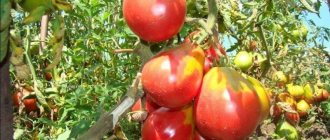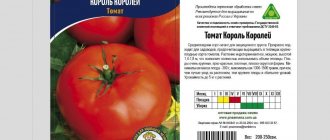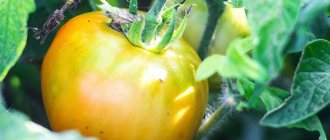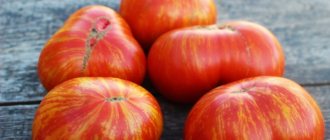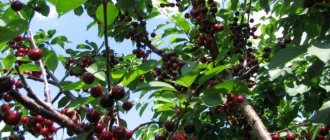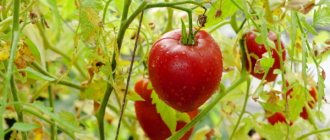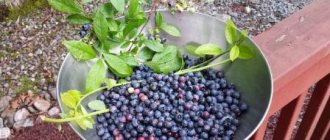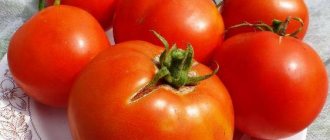The King of London tomato looks more like a tomato tree than an ordinary bush. This giant, two meters tall, is distinguished by large and delicious fruits, shaped like a heart.
Lovers of large-fruited varieties have long paid attention to it, planting it in their beds every year. Also considered a huge plus is the hardened Siberian character of the culture, which helps to survive and provide a rich harvest under any circumstances. Description of the variety, agrotechnical techniques and secrets of productivity - in the review of the article.
Description of the variety
Despite the name, the variety has nothing to do with England - it appeared thanks to amateur selection by Siberian scientists. It is not included in the State Register of Selection Achievements . But this does not prevent it from taking its rightful place among tomato crops and remaining a favorite among hundreds of gardeners.
Distinctive features
The type is indeterminate, the height of the bush is 1.5-2 m, the stem is strong, the root system is powerful . The foliage is moderate, the leaves are medium sized, light green in color. The inflorescences are simple, the first inflorescence is formed after the 9th leaf, the subsequent ones - every 2 leaves. Each brush forms 4-5 fruits.
Mid-early species , 105-110 days pass from the moment of sowing the seeds to full ripening.
The yield is high , up to 5 kg is harvested from 1 seedling, provided that no more than 3 plants are planted per 1 square meter. m.
It is distinguished by its stable immunity to the main diseases of the nightshade family, such as late blight, tobacco mosaic virus and powdery mildew.
The culture requires mandatory systematic pinching and tying up tall bushes.
Recommended for cultivation in open ground and greenhouse conditions.
Fruit characteristics
The fruits are large, average weight - 700-800 g, heart-shaped, pink or crimson in color .
The taste is excellent, sweet with a characteristic sourness, and has a high content of nutrients. The pulp is juicy, fleshy, the skin is dense. There are 6-8 seed chambers, few seeds. Universal purpose : the fruits are used for preparing various fresh dishes, cold and hot. For winter preparations, canning, marinades and pickling, vegetables have to be cut due to their large size. They are also excellent for processing into tomato products: juices, pastes, ketchups.
Ripe vegetables can be stored for a long time if the necessary conditions are created: the room should be dry and cool. Thanks to the dense peel, transportation over any distance takes place without loss of presentation.
The photo shows the King of London tomatoes.
It will be interesting:
Ideal for preservation and non-capricious “Japanese truffle”
An excellent variety for greenhouses and open ground - “Nastenka”
Variety for regions with cold climates - “Red Guard” tomato
Diseases and pests
It has strong immunity to late blight and powdery mildew. For pests (aphids, cutworms), spraying with microbiological substances is necessary.
Gardeners who have tried the “King of London” variety of tomatoes are sure to plant them in subsequent years. We wish you a great harvest!
In the table below you will find links to tomato varieties with different ripening periods:
| Mid-season | Mid-late | Late ripening |
| Gina | Abakan pink | Bobcat |
| Ox ears | French grape | Russian size |
| Roma f1 | Yellow banana | King of Kings |
| Black Prince | Titanium | Long Keeper |
| Lorraine beauty | Slot f1 | Grandma's gift |
| Stellate sturgeon | Volgogradsky 5 95 | Podsinsky miracle |
| Intuition | Krasnobay f1 | Brown sugar |
How to grow seedlings
Sowing seeds for seedlings begins 2 months before planting in the ground . All indeterminate types of plants are grown through seedlings, and this tomato is no exception.
Seed preparation
After careful inspection for visible defects, the seed is placed in a saline solution for 10 minutes . In this way, the emptiness of seeds is determined: those that float to the surface are not suitable for sowing. Then the seeds are disinfected in a weak solution of potassium permanganate for 20 minutes. After disinfection, they are washed with running water and dried.
To improve germination, the seed is germinated on damp gauze for 2-3 days . To do this, the grains are laid out on gauze slightly moistened with warm water and left in a dark and warm place at a temperature of at least 28°C. After the sprouts appear, the seeds are ready for sowing.
Reference. Germinating seeds on damp gauze significantly improves the germination rate.
Container and soil
The soil is prepared from garden soil, humus, peat and river sand in equal quantities . All components are thoroughly mixed and the resulting mixture is treated with a hot solution of manganese to destroy pathogenic flora.
Reference. Soil disinfection is a necessary and mandatory procedure for the healthy growth of seedlings.
The disinfected soil is laid out in planting containers, filling them halfway. As the seedlings grow, the remaining soil is added to containers, thereby providing additional enrichment of the root system with useful substances.
Planted both in a common box and in separate containers . When sowing in a common container, you must remember that in the future you will need to pick the plants, which can be avoided when planting in individual containers. In addition, plastic cups are convenient for transporting seedlings to a summer cottage.
Sowing
Seeds are sown to a depth of 1 cm with a distance of 2 cm from each other and sprinkled with soil on top . Lightly compact and water moderately with warm, settled water using a spray bottle. The planting containers are covered with film and left in a warm room at a temperature of 22-24°C.
The film is periodically removed to ventilate the soil. As the top layer dries out, the soil is moistened with warm, settled water.
Growing and care
When seedlings appear, the containers are moved to the windowsill . The duration of daylight for seedlings is 14-15 hours, so additional lighting is installed in advance. Water the seedlings moderately, without flooding the sprouts, with warm, settled water using a shallow watering can. After watering, the soil is loosened, thereby providing oxygen to the young roots.
When 2 true leaves appear, the seedlings dive , planting them in separate containers. The picking procedure involves removing the main root by one third, after which the lateral roots are intensively grown. During picking, weak plants are disposed of, leaving only strong and healthy bushes.
Reference. If seedlings are left in a common container after picking, it is necessary to increase the distance between seedlings to 15 cm.
During picking, the bushes are fed with liquid fertilizer for tomato seedlings.
2-3 weeks before transplantation, the seedlings are hardened off by taking them out into the open air for 1 hour during the daytime. Gradually this interval is increased to 12 hours, while simultaneously reducing the night temperature in the room to 13°C.
SIBERIAN TOMATO VARIETIES ZHENKA, KING LONDON, DIMENSIONAL
general information
When conducting a market survey on the shelves of seed stores and on the Internet resource, you can find both the King of London and simply London, which of course causes confusion and is unacceptable in the names of varieties. Consider the following “kings”:
- “King of London” from “Seeds of Altai”;
- “King London” Sverdlovsk region Russia;
- "Biotechnics" Russia;
- "Sadbrest" Belarus.
- “Siberian varietal seeds” Russia;
- Ukraine.
It should be noted that all these companies describe their selection masterpieces as folk selection.
How to grow tomatoes
After two months, the seedlings are ready for transplanting . By this time, the bushes already have 5-7 true leaves and a fully formed root system.
Landing
The soil is prepared in advance by digging and applying complex fertilizers.
Planting pattern : 50 cm – distance between seedlings, 70 cm – row spacing. For 1 sq. m place 3 plants.
Transplant on a cloudy day or in the evening into holes 20 cm deep . After transplantation, they are watered generously with warm, settled water and left to adapt to new conditions for 8-10 days.
Reference. While getting used to new conditions, the bushes are not watered or fed.
Further care
The main attention in caring for this variety is given to watering . Water generously with warm, settled water, strictly at the root, without getting on the leaves. However, it is strictly not recommended to flood the plants: the roots do not like excess moisture and can rot. On dry days, the amount of watering is increased, preventing the soil from drying out, and watering is stopped during fruiting.
After watering, the ground is loosened, removing weeds with roots .
Weeds take a lot of nutrients from the soil, which are so necessary for the full development of cultivated plants, so the proximity of tomatoes to weeds is not desirable. In addition, weeds are the cause of most fungal infections. To keep moisture in the beds longer, they are mulched with peat or straw .
This is especially necessary on hot days when moisture evaporates quickly. To obtain excellent large fruits, it is important to follow the feeding regime :
- 2 weeks after transplantation, the plants are fed with nitrogenous fertilizers. After adding nitrogen, plants intensively increase their green mass, which is necessary for healthy growth.
- During flowering, complete complex mineral fertilizers or organic matter are used. From organic matter, use mullein infusion or bird droppings in a ratio of 1:15.
- At the moment of fruit set, they are fed with phosphorus-potassium fertilizers for faster ripening of vegetables.
Growing and care
The variety is adapted for cultivation in open beds and greenhouse areas (larger tomatoes have the advantage).
Seedlings at the age of 50-55 days are transplanted into beds. The holes are placed in increments of 50 cm.
Planting density is 3-4 bushes per 1 m2.
Care elements:
- formation in 2 barrels;
- pinching 1 time every 7-10 days;
- regular watering;
- fertilization with organic matter and minerals (alternation, frequency 1 time in 2 weeks).
The nuances of breeding in open ground and greenhouses
The crop is planted in open ground in the southern regions . In areas with a temperate climate, cultivation under film is recommended, and in the northern regions - only in greenhouse conditions.
In greenhouses, the weight of ripe vegetables exceeds those grown in open beds . The yield is also higher here - up to 8 kg is harvested from 1 seedling.
The growth of greenhouse plants reaches 2 m , so pinching the crown is indispensable. This procedure is needed to indicate the growth point, since under favorable conditions the indeterminate type grows continuously.
Closed structures are regularly ventilated so as not to exceed the permissible humidity level. Otherwise, there is a risk of developing fungal spores and damaging plants with various infections. In addition, due to moisture disturbances, the fruits crack. If cracks appear, they must be coated with vegetable oil.
Video: Tomato variety King London, review
We also recommend using mulching when growing tomatoes in a greenhouse. Spread hay, straw, or slightly dried grass between the tomato bushes in a layer of 5-7 cm, covering all exposed soil. This helps retain moisture in the soil and also prevents weeds from growing. But the most important thing is that the humidity in a greenhouse with mulched beds is much lower, which means that there are no favorable conditions for the development of late blight.
Other interesting varieties of tomatoes with photos and descriptions can be viewed in our Tomato Catalog. Enjoy watching!
If you grew King of London tomatoes, please write whether you liked them or not. What was the yield and taste of the fruits like under your climatic conditions? How do you rate the disease resistance of this variety? Briefly describe the advantages and disadvantages of this tomato in your opinion. If possible, attach a photo of your tomatoes to your comment. Thank you!
Your reviews of the King of London tomato and additions to the description will help many gardeners evaluate this variety more objectively and decide whether it is worth planting or not.
Harvesting and application
Ripe vegetables begin to be collected in July . Large fruits are of the salad type, so they are ideal for fresh consumption. They are used to prepare excellent summer salads, vegetable stews, and hot dishes: soups, stews with vegetables and meat. As for canned food, vegetables have to be cut due to their large size. Therefore, they do not try to make winter preparations from them. But they are allowed to process tomato products, since tomatoes perfectly retain sourness in juices, pastes, adjika and ketchup.
Thanks to their thick skin, ripe vegetables can be stored for a long time in a cool, dry place, until November. This is undoubtedly a big plus, since you can pamper yourself with fresh summer salads all fall.
Pros and cons of the variety
Those summer residents who have already encountered the cultivation of the King of London cannot boast enough about its positive qualities.
Advantages
- the variety is unpretentious in cultivation;
- withstands light frosts, winds, and temperature changes;
- equally productive in the southern and northern regions;
- is immune to tomato diseases;
- The fruits stand out not only for their large size, but also for their high tasting qualities.
Against the background of such a list of pros, the cons are simply lost. But they are also worth mentioning.
Flaws
- despite good transportability, the variety is not suitable for long-distance transport;
- London cannot be stored for long;
- The fruits on the bush ripen gradually, so it is not possible to take the entire harvest from the bush in one go.
These disadvantages are insignificant if you grow the variety for personal use in salads or for preparations.
Advantages and disadvantages
Culture has many positive properties:
- adaptation to weather conditions;
- high resistance to diseases;
- ease of care;
- high fruiting rate;
- mid-early maturation;
- excellent taste;
- large fruits;
- universal purpose;
- long storage;
- long transportations.
Negative properties include:
- regular stepsoning;
- obligatory garter;
- cracking of fruits due to high humidity.
Characteristics of what we have
Looking through the description, it becomes clear that all these descriptions have one thing in common - the tomatoes should be large-fruited. But everyone has their own vision of the “king” further.
Description of the variety
- From this you will get mid-early tomatoes. The bush claims a height of no more than 150 cm. The tomato fruit is in the range of 200-250 g, pepper-shaped with a slightly elongated tip, the so-called “spout”. By sowing seeds from this packer, you will receive red, fleshy tomatoes with smooth skin and dense, aromatic, tasty pulp for salad purposes and processing into tomato products;
- By choosing a “King of London” tomato, you will become the owner of a medium-late tomato. The manufacturer promises the height of the plant form to be up to 200 cm, but only with good care.
The weight of the fruit will be in the range of 150-300, but also 700 g, as if it were possible to achieve. The shape is rounded-pyramidal, although professional breeders don’t even know about this shape of tomatoes.
Farmer reviews
Judging by the opinions of gardeners, the culture is very popular among gardeners .
Yulia, Odessa : “The variety is tall, the bushes have grown 1.8 m. Despite the fact that I did not completely plant them, the harvest turned out to be large. The fruits weighed 500-600 g, so one tomato is enough to prepare a salad for two people. I was especially surprised by the taste – real, tomato.”
Georgy, Chelyabinsk : “I was visiting a friend, and he showed me photographs of his favorite tomatoes. I immediately noticed the massive bushes with huge heart tomatoes. I planted it in my greenhouse. Watered and fed infrequently. The vegetables are ripe, delicious, meaty and without unpleasant veins. Very satisfied!".
Best reviews from our readers
- An excellent variety, very large fruits, average yield, closer to high, excellent taste of the fruit. Mid-season. I planted it in a glass greenhouse.
- An excellent variety, very large fruits, average yield, closer to high, the taste of the fruit is excellent. Mid-season. Planted it in a glass greenhouse. Late blight is weakly affected.
- I love raspberry tomatoes, they are the most beautiful and delicious. I begged one tomato from a neighbor in the summer; it seemed very beautiful to me. I collected my seeds and will plant them this season. The taste is amazing, real, tomato. If the yield does not fail, then it will be absolutely good. I will definitely take a photo on the bush.
- Productive, large-fruited, weakly leafy, just right for a greenhouse!!! Overall 5+
You can buy tomato seeds “King of London” from the seller Valentin RedkoRoyal GardenAssessment of those who grew:
King London is a popular variety from the early ripening line of tomatoes, valued for its fleshy giants with an excellent sweet and sour taste. The cultivar is actively grown in regions with different climates.
| Height | Landing location | Ripening time | Fruit color | Fruit size | Origin | Fruit shape |
| Tall | Greenhouse, Open ground | Mid-early | Pink | Large | Variety | Flat-round |
Landing
Sowing takes place from the beginning of March. For seedlings, special soil is selected with the indication “for peppers and tomatoes.” The soil is pre-disinfected:
- calcined for 30 minutes in the oven;
- spilled with Fitosporin, potassium permanganate.
Before planting, seeds are disinfected, calibrated, stimulated (Agate, Zircon, Epin).
What are the subtleties of caring for seedlings:
- irrigation with water 24-25 degrees;
- keeping under film until germination;
- picking into separate containers or boxes (distance 8-10 cm);
- hardening with a gradual decrease in temperature to 12-14 degrees 10 days before planting.

